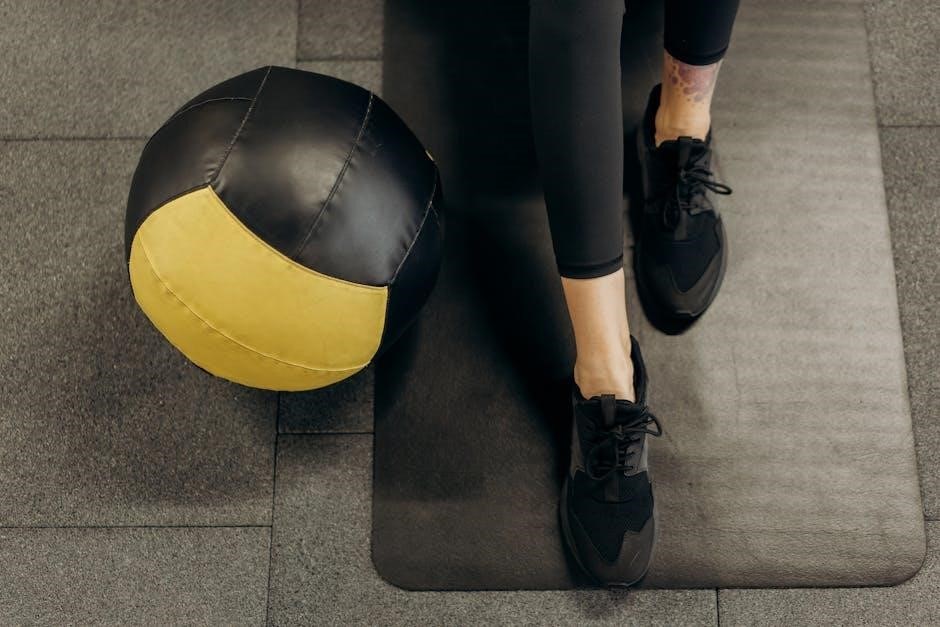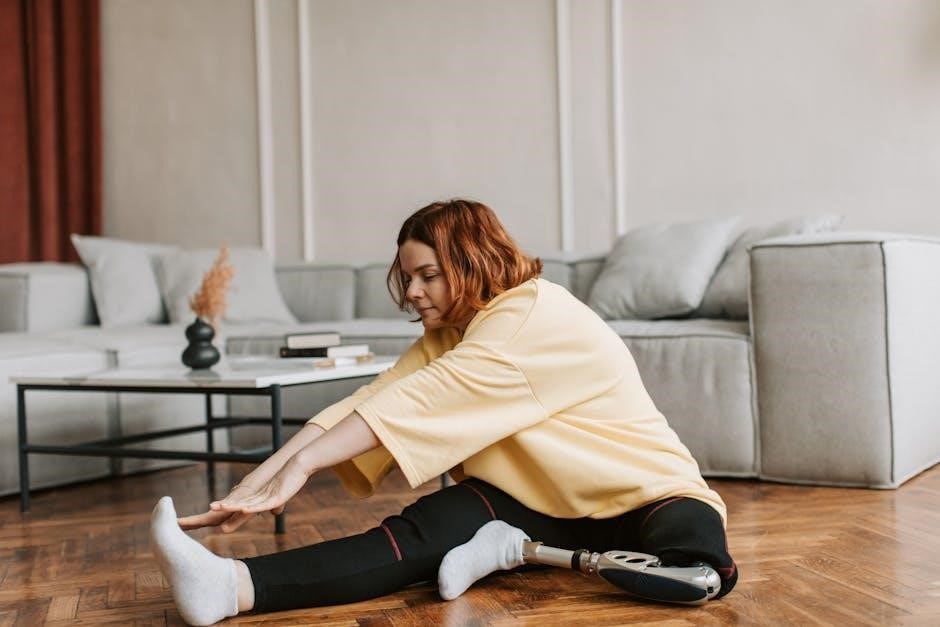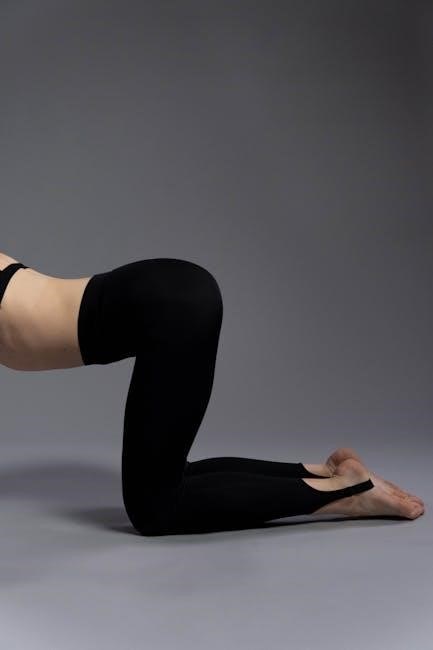Cable leg workouts are a popular method for strengthening lower body muscles using cable machines. They offer versatility, targeting multiple muscle groups effectively while providing consistent resistance.
1.1 What Are Cable Leg Workouts?
Cable leg workouts involve using cable machines to target and strengthen various leg muscles. These exercises utilize a cable system to apply resistance, allowing for controlled movements that work multiple muscle groups simultaneously. They are versatile, enabling users to perform exercises like cable squats, lunges, and leg presses. Cable leg workouts are effective for building strength, improving muscle endurance, and enhancing overall lower body development.
1.2 Benefits of Cable Leg Workouts
Cable leg workouts offer numerous benefits, including improved muscle strength, enhanced endurance, and better flexibility. They provide consistent resistance throughout exercises, promoting balanced muscle development. Cable machines allow for targeted workouts on specific muscle groups, such as quadriceps and hamstrings. Additionally, they enable low-impact exercises, reducing joint strain compared to heavy weightlifting. This makes cable leg workouts ideal for individuals seeking effective, injury-free leg training.
1.3 Why Use Cable Machines for Leg Training?
Cable machines are ideal for leg training due to their versatility and ability to target multiple muscle groups. They provide smooth, consistent resistance, reducing joint stress compared to free weights. Cable machines allow for a variety of exercises like squats, lunges, and leg presses, making them a comprehensive tool for leg development. Their adjustable resistance and precise control ensure efficient workouts, catering to both beginners and advanced athletes. They enhance muscle balance and promote overall lower body strength effectively.

Essential Equipment for Cable Leg Workouts
Cable machines are the cornerstone of cable leg workouts, offering adjustable weight stacks and interchangeable handles. They provide the necessary resistance and versatility for effective leg training.
A cable machine typically consists of a sturdy frame, pulleys, and a weight stack. Accessories like adjustable handles, ankle straps, and rope attachments enhance functionality. Proper setup ensures smooth operation, allowing for varied exercises targeting different leg muscles. Regular maintenance of cables and pulleys is crucial for longevity and safety during workouts. The adjustable weight stack allows users to customize resistance levels, catering to different fitness goals. Handles and attachments, such as bars or straps, provide versatility for various exercises. The weight stack’s ease of adjustment ensures efficient transitions between sets, while ergonomic handles promote a secure grip, reducing fatigue and enhancing workout safety. This adaptability makes cable machines ideal for both beginners and advanced trainees. Cable machines are equipped with essential safety features to prevent accidents. Emergency stop mechanisms and secure weight pins ensure safe operation. Adjustable limits on the cable’s range of motion minimize the risk of overextension. Durable construction and regular maintenance further enhance safety, making cable machines a reliable choice for effective and injury-free leg workouts. These features are crucial for protecting users during intense training sessions. Cable leg workouts include exercises like cable squats, lunges, leg press, and curls/extensions. These movements target multiple muscle groups, providing consistent resistance for effective leg development and strength. Cable squats target the quadriceps, hamstrings, and glutes. Stand facing the cable machine with the handle at shoulder height. Grip the handle firmly, engage your core, and maintain a chest-up position. Lower into a squat, keeping your back straight and knees over your toes. Push through your heels to return to the starting position. Focus on controlled movements and use resistance that challenges your muscles without sacrificing form. This exercise improves balance and lower body strength effectively. Cable lunges effectively target the quadriceps, hamstrings, glutes, and calves. Stand facing the cable machine with the handle at shoulder height. Grip the handle, step forward with one foot, and lower into a lunge, keeping your back straight and chest up. Push back to the starting position, alternating legs. This exercise improves balance, isolates leg muscles, and enhances overall lower body strength. Proper form is essential to avoid injury. The cable leg press is an effective exercise for targeting the quadriceps, hamstrings, and glutes. Sit at a cable machine with your feet shoulder-width apart on the platform. Push the platform away, extending your legs, then slowly return to the starting position. This exercise provides constant tension, helping to build strength and muscle mass. Adjust the weight and foot position to focus on different muscle groups, ensuring proper form to prevent injury. Cable leg curls target the hamstrings, while leg extensions focus on the quadriceps. For leg curls, sit facing the cable machine with your legs extended, then pull the cable towards your calves. For leg extensions, sit with the cable attached to your feet and push the weight forward. Both exercises isolate specific muscle groups, promoting balanced leg development. Focus on controlled movements to engage the target muscles effectively and avoid injury. Adjust the weight and resistance based on your fitness level for optimal results. A structured cable leg workout routine includes exercises like cable squats, lunges, and leg presses, with sets and reps tailored to your fitness goals. A dynamic warm-up is essential before starting cable leg workouts. Begin with 5-10 minutes of light cardio, such as jogging or cycling, to increase blood flow. Follow with dynamic stretches like leg swings, lunges, and hip circles to prepare major muscle groups. Adjust the cable machine to your height and ensure proper footing. Finish by mentally preparing for the workout, focusing on form and execution. This preparation ensures safety and effectiveness. Begin with compound movements like cable squats or lunges to engage major muscle groups. Follow with isolation exercises such as cable leg curls or extensions. Aim for 3-4 sets of 8-12 reps per exercise. Rest for 60-90 seconds between sets and 120-180 seconds between exercises. Maintain a steady pace, completing the workout within 45-60 minutes. Adjust timing based on fitness level to optimize results and avoid fatigue. Ensure smooth transitions between exercises. After completing your cable leg workout, dedicate 5-10 minutes to cooling down. Perform static stretches for hamstrings, quadriceps, and calves, holding each for 20-30 seconds. Gentle leg swings and walking lunges can also help reduce muscle tension. Incorporate deep breathing to lower heart rate and promote relaxation. Dynamic stretches, such as high knees or butt kicks, can gradually transition your body to a resting state. This routine enhances flexibility and reduces post-workout soreness. Progression strategies for cable leg workouts involve gradually increasing weight and resistance, varying repetitions and sets, and incorporating advanced techniques like drop sets or supersets. Allow muscle recovery time and adjust routines based on progress for optimal results. Increasing weight and resistance in cable leg workouts is essential for muscle growth and strength. Start with manageable loads and gradually add weight as strength improves. Focus on controlled movements to maintain form and prevent injury. Incremental increases ensure progressive overload, which is crucial for continuous muscle development. Proper form and full range of motion are key to maximizing gains while minimizing risk. Varying repetitions and sets is crucial for optimizing muscle development. Lower reps with heavier weights target strength, while higher reps improve endurance. Adjusting sets prevents plateaus and keeps workouts engaging. For example, alternate between 3-4 sets of 8-12 reps for hypertrophy and 4-5 sets of 12-15 reps for endurance. This variability ensures comprehensive muscle stimulation and promotes balanced leg development over time. Consistency and progressive changes yield the best results. Incorporating advanced techniques like drop sets, supersets, and partial reps can enhance cable leg workouts. Drop sets involve reducing weight for additional reps, while supersets combine exercises for intensified sessions. Partial reps target specific muscle ranges, improving strength and definition. These methods increase workout intensity and challenge muscles differently, preventing stagnation and fostering continuous progress. They are ideal for intermediate to advanced lifters seeking to push their limits effectively. Always inspect equipment, use proper form, and avoid overtraining. Begin with lighter weights, engage your core, and stay within a comfortable range of motion to prevent injury. Maintaining proper form is crucial during cable leg workouts to prevent injuries. Always warm up, use appropriate weights, and engage your core. Ensure full range of motion without sacrificing technique. Avoid rounding your back or using jerky movements. Keep your knees in line with your toes during exercises like cable squats or lunges. Proper form ensures effective targeting of muscles and minimizes injury risk. Stay focused and controlled throughout each movement. Cable machines use pulleys and cables to provide resistance, allowing for smooth, controlled movements. The weight stack determines resistance, with cables redirecting force to target specific muscles. Understanding how to adjust the weight and position yourself correctly is key for effective workouts. Familiarize yourself with the machine’s mechanics to ensure proper alignment and avoid misuse, which can lead to injury or ineffective exercises. Proper setup enhances safety and workout efficiency.
Preventing overtraining is crucial for effective cable leg workouts. Overtraining can lead to muscle fatigue, injury, and decreased performance. Ensure adequate rest between sets and workouts, and maintain a balanced routine. Monitor progress and adjust intensity gradually. Signs of overtraining include persistent soreness and decreased strength. Incorporate recovery techniques like stretching and proper nutrition to support muscle repair and growth, ensuring sustained progress without burnout. Consistency and patience are key to long-term success. Proper nutrition and recovery are essential for optimizing cable leg workout results. Ensure adequate protein intake to repair muscles, balanced with carbohydrates and fats for energy. Hydration is key, and post-workout recovery techniques like stretching and rest support muscle growth and prevent injury, enhancing overall performance and progress. Protein is crucial for muscle repair and growth after cable leg workouts. It helps rebuild muscle fibers damaged during exercise, promoting strength and hypertrophy. Aim for 1.2-2.2 grams of protein per kilogram of body weight daily from sources like lean meats, fish, eggs, and plant-based options. Timing matters—consume protein within an hour post-workout to maximize muscle synthesis and recovery. Proper hydration also supports nutrient absorption and muscle function. Carbohydrates are the primary energy source for intense cable leg workouts, fueling muscle contractions and high-intensity efforts. Complex carbs like whole grains and vegetables provide sustained energy, while simple carbs offer quick bursts. Fats, particularly healthy fats, support hormone production and aid in the absorption of fat-soluble vitamins. Balancing carbs and fats ensures optimal energy levels and supports overall muscle function during and after workouts. Proper intake enhances performance and recovery.
Proper recovery is crucial after cable leg workouts to repair and strengthen muscles. Techniques include stretching, foam rolling, and massaging to improve blood flow and reduce muscle soreness. Rest days and sleep are essential, allowing muscles to rebuild. Active recovery, such as light cardio, can also enhance the healing process. Additionally, incorporating ice or heat therapy helps reduce inflammation and promotes faster recovery, ensuring optimal muscle function for future workouts. Cable leg workouts are highly effective for building strength and muscle endurance. They offer versatility, targeting multiple muscle groups with consistent resistance, ensuring a well-rounded leg development routine. Cable leg workouts are highly effective for enhancing strength, endurance, and muscle definition. They offer versatility, targeting multiple muscle groups with controlled resistance, making them ideal for balanced leg development. Regular use of cable machines can improve muscle imbalances and overall lower body functionality, complementing other training methods for a well-rounded fitness routine. Consistency and proper form are key to achieving optimal results and preventing injury. To maximize the effectiveness of cable leg workouts, start with realistic goals and focus on proper form to prevent injuries. Incorporate variety in your routine to keep it engaging and avoid plateaus. Adjust resistance and repetitions according to your fitness level, and stay consistent for visible progress. Listen to your body to avoid overtraining, and always use a full range of motion for optimal results. Combine your workouts with a balanced diet to support muscle growth and recovery. Stay motivated, and you’ll achieve your fitness goals in no time!2.1 Cable Machine Setup and Accessories
2.2 Adjustable Weight Stack and Handles
2.3 Safety Features of Cable Machines

Key Exercises for Cable Leg Workouts
3.1 Cable Squats: Proper Form and Execution
3.2 Cable Lunges: Targeting Different Leg Muscles
3.3 Cable Leg Press: Maximizing Leg Development
3.4 Cable Leg Curls and Leg Extensions

Sample Cable Leg Workout Routine
4.1 Warm-Up and Preparation
4.2 Exercise Order and Timing
4.3 Cool-Down and Stretching
Progression Strategies for Cable Leg Workouts
5.1 Increasing Weight and Resistance
5.2 Varying Repetitions and Sets
5.3 Incorporating Advanced Techniques

Safety Tips for Cable Leg Workouts
6.1 Proper Form to Avoid Injury
6.2 Understanding Cable Machine Mechanics
6.3 Preventing Overtraining
Nutrition and Recovery for Cable Leg Workouts
7.1 Importance of Protein Intake
7.2 Role of Carbohydrates and Fats
7.3 Recovery Techniques for Leg Muscles
8.1 Summary of Key Points
8.2 Final Tips for Effective Cable Leg Workouts